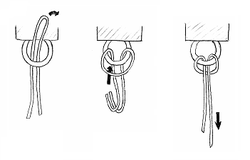Difference between revisions of "Translations:AY Honors/Knot/Lark's head/2/es"
From Pathfinder Wiki
(Created page with "</noinclude> {{Knot/es | image = Cowhitch.png | name = Nudo alondra | use = El '''nudo alondra''' (mas un enganche), también llamado enganche de vaca, comprende dos medio cot...") |
m (FuzzyBot moved page Translations:Adventist Youth Honors Answer Book/Knot/Lark's head/2/es to Translations:AY Honors/Knot/Lark's head/2/es without leaving a redirect: Part of translatable page "Adventist Youth Honors Answer Book/Knot/Lark's head") |
(No difference)
| |
Latest revision as of 15:53, 8 September 2021
| Nudo alondra |
|---|
|
Uso: El nudo alondra (mas un enganche), también llamado enganche de vaca, comprende dos medio cotes atados en direcciones opuestas. El nudo alondra se usa a menudo para conectar cordones de equipos electrónicos de mano, ya que puede atarse sin acceso a los extremos del bucle.
Cómo amarrar:
|

